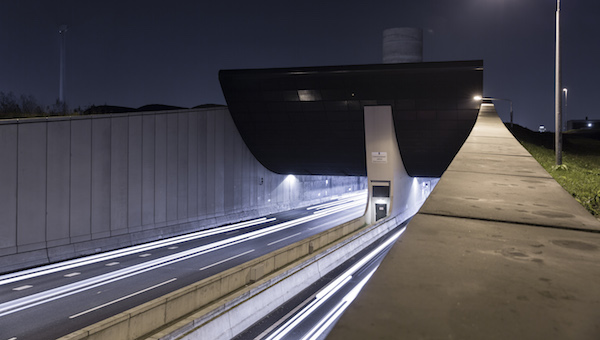
As a result of the construction of the new Coentunnel, opened in May 2013, the existing 40-year-old tunnel was closed for renovation. The older structure has now been reopened to traffic, bringing this major project to an end. The two 750-metre tunnels, which are located under the port of Amsterdam, will relieve congestion on Amsterdam’s busy western ring road and ease the flow of traffic going north. The 200,000 customers expected on a daily basis will now have 8 lanes available to them, rather than 5 as was formerly the case.
Total project investment was €517 million. Coentunnel Company, a jointly owned subsidiary of VINCI Concessions, CFE and its subsidiary Dredging International, and their Dutch and Belgian partners will operate the infrastructure as a whole for 24 years in compliance with the contract.
This 5-year project was carried out by a consortium consisting of VINCI Construction Grands Projets and CFE, DIMI, TBI, Dura Vermeer, and Besix. The consortium delivered a turn-key solution that includes an automated traffic-management system.

The new contract was signed in Paris on 23 June 2014 at a ceremony attended by François Hollande, President of the French Republic, and His Highness Sheikh Tamim Bin Hamad Al Thani, Emir of Qatar, who is on an official visit to France.
This design-build contract with a value of about €2 billion will be built by QDVC in a consortium with Alstom. It comprises construction of 25 stations and a depot, architectural and electro-mechanical works packages, integrated project management, delivery by Alstom, for €750 million, of 35 trains equipped with catenary-free technology, track-laying, energy supply and telecommunications as well as control systems. The light rail system is scheduled to begin operating in 2018 (yellow line) and 2020 (green, red and purple lines).
The city of Lusail, a new urban development with a population of 200,000 north of Doha, the capital of Qatar, will welcome up to 450,000 users per day. Sustainable development was a primary criterion in planning the new city. From the start, the design included the creation of a public transport system to limit greenhouse gas emissions. QDVC completed the civil engineering works on the first phases of the infrastructure (7 km of tunnels, 7 underground and 4 above-ground stations, as well as an access viaduct to the depot) and is currently building the Pearl station, which will connect the Lusail light rail with the Doha metro system, also under construction. In seven years, VINCI Construction Grands Projets has become, through QDVC, a major construction player in Qatar.
After handing over the country’s largest wastewater pumping station, the company is currently working on several projects: a new motorway on the outskirts of Doha (the New Orbital Highway), the Doha metro (southern works package of the red line) and the underground car park and landscaped gardens at the Sheraton hotel in the West Bay business district.

Entrepose Contracting and VINCI Construction Grands Projets, both subsidiaries of VINCI, have been awarded a contract with JSC Yamal LNG, owned by NOVATEK (80 %) and TOTAL (20 %), to perform an engineering, procurement, supply, construction and commissioning contract covering four cryogenic full-containment liquefied natural gas (LNG) storage tanks (each composed of a 9% nickel stainless steel interior container and a pre-stressed concrete external container) with a capacity of 160,000 cubic meters each.
These tanks will form part of a 16.5 million tons per annum natural gas liquefaction project, which will utilise the resources of the South Tambey Gas Condensate Field situated in the Yamal Peninsula in the Russian Federation.
In order to meet the project schedule requirements to make the first 2 tanks available in 2016, the detailed engineering, supply of the first equipment, camps, temporary facilities and piling works in the permafrost were started in June 2013 under a Letter of Award arrangement.
Entrepose Contracting and VINCI Construction Grands Projets have a track record of building more than 30 LNG storage tanks in 11 different countries over the last 20 years.
The €60 million contract covers design and construction of a four-level car park, a three-storey podium of shops and a 10-storey office tower with a total surface area of 65,000 sq. metres, located in the northern part of the island of Borneo. The work will get under way on 1 August 2013 and handover is scheduled on 31 March 2015.
With this new contract, VINCI Construction Grands Projets reinforces its operations in Malaysia, where it handed over the 700,000 sq. metre Berjaya Times Square project, Asia’s largest contiguous residential and shopping complex, in Kuala Lumpur in 2003 and is currently building the 185,000 sq. metre Berjaya Central Park project.
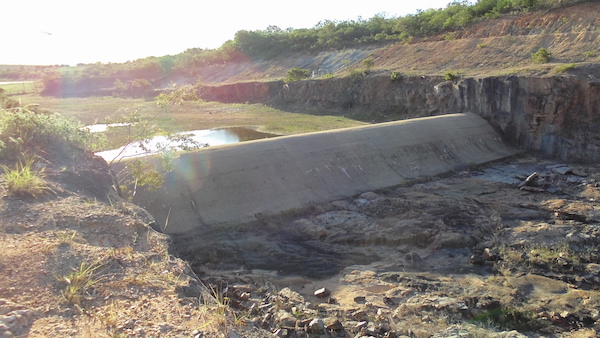
The contract calls for the spillway on the De França dam to be raised by 1.5 metres by installing fusegates along the dam’s 55-metre sill. As a result, the structure’s storage capacity will be increased by 7 million cubic metres, which is 30% of its current capacity.
The De França dam (France dam), located in the Northeast Region of Brazil, one of the country’s 5 regions, fills completely during the rainy season and provides drinking water to the municipalities of Piritiba and Miguel Calmon year-round. In 2012, the Northeast Region of Brazil experienced such severe drought that the State of Bahia declared a state of emergency in half of its municipalities. The present contract is designed to enable the authorities to respond to the region’s growing water-related needs.
This is Hydroplus’s first contract in Brazil. Work will have to be completed in 10 months.
Other similar mandates for the Northeast Region of Brazil are under study. The region contains over 300 dams for water supply, irrigation, and energy production.
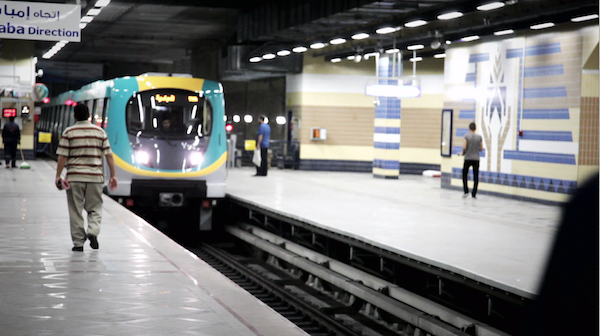
The contract, totalling €40 million, includes civil engineering for the Haroun station and the completion of 680 metres of tunnel extension between the Al Ahram and Haroun stations. Excavation will be done with the existing Imothep tunnel-boring machine, awaiting restart in the Al Ahram station since October 26, 2012.
Construction work will begin immediately and should be completed within 17 months. This new phase should allow Phase 2 to be put into service up to the Al Ahram station by mid-2014.
The next step is the attribution of phases 3 and 4 of Line No. 3 which, once completed, will run beneath the Egyptian capital from east to west, connecting the airport to the neighbourhoods west of the Nile River.
This new contract reflects the confidence that the Egyptian Ministry of Transportation has shown for VINCI over the past twenty years. The Group has already constructed lines 1 and 2 of the Cairo metro system, in addition to Phase 1 of Line No. 3, inaugurated on February 21, 2012, and which serves the eastern section of Cairo from its downtown core.

VINCI Construction Grands Projets and Bachy Soletanche Ltd (VINCI Construction), members of the BBMV consortium along with Alpine Beton und Monierbau, Balfour Beatty and Morgan Sindall, have won the €275 million contract (VINCI’s share: 36.7 %) to build the tunnels for the Liverpool Street and Whitechapel stations in London. The contract is part of the Crossrail project, which will provide an express rail link running east-west across London in 2018.
It calls for the construction of the Liverpool Street and Whitechapel station tunnels and associated works. Each station has two platforms approximately 400 metres long, numerous cross-passages and underground branches connecting to the new Crossrail stations.
The works represent a total of about 190,000 m³ of excavation and 60,000 m³ of concrete lining. They are scheduled to start in February 2011 and will take approximately five years to complete.
VINCI Construction Grands Projets is a world leader in underground works, with numerous references and 10 tunnel boring machines in action in 2011 on the group’s worksites. These include the Hallandsås and Liefkenshoek rail tunnels in Sweden and Belgium, respectively, as well as the Cairo metro in Egypt.
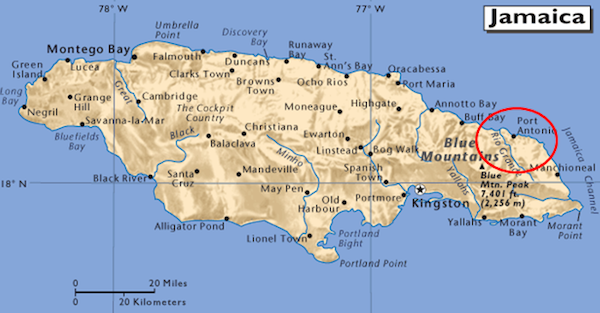
The first contract for the Jamaica Water Supply Improvement Project (JWSIP) – Category B is an extension of the JWSIP – Category A project that has been already carried out by VINCI Construction Grands Projets and voted “Project of the year 2012” in Jamaica out of all types of engineering projects done on the island.
For this latest project, VINCI Construction Grands Projets will replace the water transfer pipes that supply the urban area of Kingston and that currently have a large number of leakages. The new raw water pipes will also supply a new water treatment station on the Rio Cobre river. Three drinking-water treatment plants on the northern coast of Jamaica will also be rehabilitated. The works, totalling $62 million (about €47 million), will start at the beginning of 2013 and will last 24 months.
The second contract in Port Antonio, in the north east of Jamaica, covers the laying of water-supply pipes in the urban region, as well dredging works and the construction of an outlet to the sea. This work represents the second phase of a project carried out in the same town by VINCI Construction Grands Projets in 2010.
The works, which will cost $17.5 million (approximately €13 million), started in December 2012 and will last 18 months.
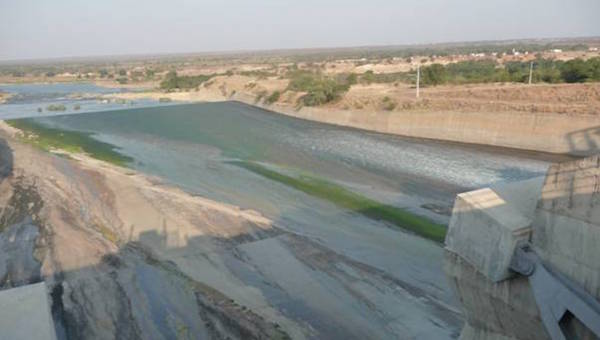
The project is part of a contractual agreement between China Henan Company and ARA-Sul (the regional water management authority), funded by the African Development Bank, for the construction of an auxiliary spillway.
The Massingir Dam is located on the Olifants River, a tributary of the Limpopo, in southern Mozambique. The dam was built in the 1970s to irrigate the land, control floods, and generate electrical power, but its spillway was unable to discharge peak floods. The auxiliary spillway, equipped with 14 straight fusegates, each 5.8 high and 11.23 m wide, will, in conjunction with the main spillway, provide total discharge capacity of 34,000 m3/s. The fusegate system, developed exclusively by Hydroplus, was selected by the firm Tractebel Engineering, a subsidiary of GDF SUEZ, from among other solutions, including fixed labyrinth spillways and fuseplug dykes.
Design studies will be conducted in 2012 and installation will be carried out in 2013.
This first ever contract in Mozambique marks Hydroplus’s return to southern Africa, where several other dams are equipped with fusegates: Eikenhof and Shongweni in South Africa, Ruti and Ruia in Zimbabwe, and Kamuzu in Malawi.
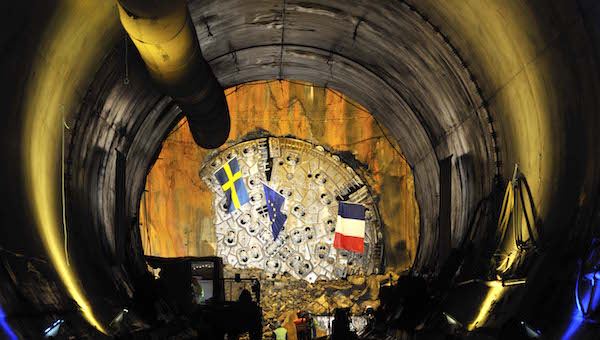
The project, which is part of the renovations to be done to the railway line running between Malmö and Göteborg, aims to considerably increase traffic on the line and to double the maximum weight of freight trains using this route.
The Åsa tunnel boring machine was designed to drill into very heterogeneous terrain (highly altered or instable firm rock) in which water seepage can reach high levels (up to 400 l/s). An entire range of terrain treatment processes (in particular, injection), allowing to overcome these difficulties while being in compliance with the water laws applicable to this project, can be carried out at the tunnel boring machine level.
In order to help the tunnel boring machine make its way through the northern segment of the second tunnel that is yet to be dug, injection work is currently being carried out from two branches. The purpose of this injection work is to reduce water seepage into the 800-metre-long highly aquiferous area known as Lya.
At the same time, the freezing of the Mölleback fault, made up of altered, fractured and heterogeneous rock, started on the first 85 metres. Digging a gallery in the frozen ground is ongoing in order to allow the freezing of the next 115 metres. The Åsa tunnel boring machine is scheduled to start excavating in the Mölleback fault in early summer, 2013.
85 % of the two main tunnels have been completed. The remaining 3 kilometres of tunnel to be dug should be completed by the end of 2013, and the project is set for commissioning in 2015.
In 2002, VINCI Construction Grands Projets, along with Skanska, was mandated to design and build these two tunnels, each 5,500 metres long, with an inside diameter of 9.04 metres, through the Hallandsås hillside, as well as twelve inner tube tunnels (four measuring 39 metres long, and eight measuring 21 metres long). The first two tunnels were bored on August 25, 2010.











